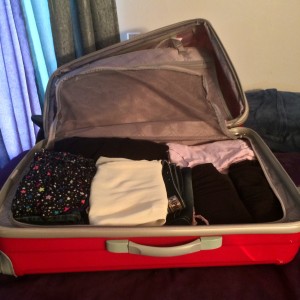I’m excited to announce that I will be taking a short trip this weekend. I’ll be in Los Angeles from June 13 through the 17th. I’m going to visit friends and attend Theodore Bikel’s 90th birthday celebration. I’ll get to spend time with two of my best friends – Paul, who lives there, and Tamra, who will be visiting for the event. I can’t wait!
As I’m packing and getting ready to go, I realized it might be helpful to share some of my tips for what to bring, etc. and useful things to know when traveling with a disability.
At the top of the page, you can see my cute red suitcase. It’s the largest of a set of three. After going through tons of luggage in a short time, I discovered the wonders of hard sided suitcases. They are more durable than fabric suitcases, and do a better job protecting your valuables. Although they can be more expensive, keep an eye out for good deals, and you’ll save money in the long term because they last three times as long.
The set I use is surprisingly lightweight and has quality wheels and handle – always look at those when shopping for luggage, as they typically wear out long before the body of the suitcase. Many years ago my grandmother bought me a beautiful luggage set as a high school graduation gift – it was expensive, with thick fabric and stitching, but that was back in the days when I used to fly, and after a few plane rides the handle and wheel broke on the medium-sized suitcase, the one I used most.
I opt for colorful luggage because well, I’m a colorful person, but it also has the practical benefit of being distinctive. It’s less likely to be stolen, left behind at a hotel room, or confused with another suitcase at baggage claim. “Many bags look alike” – not my bags!
The next decision is how big of a bag to bring. I will admit it, I’m a clothes horse, so I always bring a few extra outfits to allow for emergencies or just changing my mind about what I want to wear. If you’re disabled, think about potential medical issues and complications that might require extra clothing changes. I like to wear jeans to look the best when I travel, but they can be constrictive, so I bring a few extra pairs of nice stretch or drawstring pants in case I’m in pain or bloated. These can double as sleeping pants, so they don’t take up more room in the suitcase, I just choose the nicest pairs I have.
You can fit a lot more in if you pack efficiently. Put socks and undergarments into bags, or just roll them up, and stash them along the edges of the suitcase. If you have space bags, you can save some room, but not as much as you think. I rarely bother with them anymore. Always put toiletries in a separate bag within your suitcase – I learned that lesson years ago when a bottle of shampoo ruined my toothbrush and spilled all over my clothes. If you think something might leak, put it in a separate Ziploc bag inside your toiletries bag.
I put clothes together into outfits when I pack. This serves several useful functions. First, I know that every shirt I bring has matching pants, and vice versa. I’ve already pre-matched items in the best possible combination, so I’m not fussing over them when trying to get dressed for the day or a special event. I rarely re-wear items without washing them first, so on a longer trip when laundry is necessary, I match again, sometimes choosing different combinations. It’s a good idea to bring items that can be mixed and matched to give you more variety. The same goes for jewelry.
If you’re going on a road trip with overnight stops before you get to your main destination, I recommend packing a smaller go bag with just a few necessities. Then you can just bring that bag into the hotel, and not your larger suitcase. I typically wear comfortable clothes and stretch pants on days when I’ll be in the car for 8+ hours, so I can fit a few outfits into a small bag, plus toiletries. Since I’ve been in the car all day I don’t usually need my wheelchair battery charger.
It can be hard to pack light when you have a disability, because of the extra equipment needed. I bring a step stool which serves as a foot rest in the shower – that was a big inconvenience until I discovered folding plastic stepstools that collapse to about an inch thick. I often bring a shower chair as many hotels don’t provide one, even though they’re supposed to, and the ones they do provide are often small and flimsy. I am still in search of a sturdy folding shower chair, but for now I have a regular one. If you’re flying you can often rent one from a local medical supply store. They also rent out manual wheelchairs for a low cost – useful if you need to get into someone’s home that is not wheelchair accessible, as they are typically much narrower than a regular wheelchair, and easier to lift up steps.
If you use a power chair, you’ll need to consider how to transport your battery charger. My first power wheelchair had an enormous battery charger that needed a suitcase to itself. My second wheelchair had a built in charger which was great – I could plug into any outlet anywhere. It was nice to never have to think about packing a charger.
I’m now on my third power wheelchair, and it came with a large charger that’s almost as big as the first one. I was very irritated when I got it, and asked about a smaller one. The dealer I went through was lousy, but I had to use them because they were in network for my insurance. They claimed there were no smaller chargers. I’ve since learned that isn’t true, but have not had a chance to get one yet. I plan to before my next big trip, as they are about the size of a laptop power adapter. Of course they cost three times as much.
If you plan on flying with your power wheelchair, make sure that you have gel cell batteries, not lead acid. Gel batteries are safer, and are common today, so chances are you have them, but doublecheck to make sure. I recommend either disconnecting your joystick and removing it from the chair to carry on the plane with you, or wrapping it in foam or bubble wrap. You want to make sure it’s not damaged being loaded in and out of cargo. You may also want to bring your seat cushion on the plane – if it fits in the tiny airplane seats! Remember, airlines cannot charge you extra fees for your wheelchair or any other mobility equipment.
It is your right to have your service dog with you on the airplane, Amtrak, and all other forms of public transportation. Unlike other public locations, airlines can require a doctors letter regarding your need for a service dog. This is especially important if your disability is not visible – such as seizures, PTSD, etc.
Unfortunately (in my opinion) untrained animals can also be allowed on the plane as emotional support animals, with a letter from a doctor. Many people are abusing this loophole to get their pets onto airplanes. While I agree that cargo isn’t a safe place for any animal, I cannot support falsifying your dog as a service or emotional support animal. If the current state of flying bothers you, lobby airlines to offer select pets welcome flights, and provide climate controlled kennels that pet owners can visit when the seatbelt sign is off.
When traveling by car, as I typically do, how you pack is almost as important as what you pack. I always have a bag with road necessities right behind the driver’s seat. Snacks, soda, drinking straws, water and a bowl for the dog, napkins or paper towels, and hand sanitizer are all good things to have handy. Also don’t forget duct tape and WD-40! You never know when you’ll need them. I was on the freeway on my way to Boston when the trim on my car started dragging on the road. It could have become a hazard or delayed the trip, but we pulled off at the next exit, secured it with duct tape, and were good to go. WD-40 can work wonders on a stuck ramp or lift.
My service dog Aria rides in a crate secured with wheelchair tiedown straps. Although it takes up a lot of space in the car, I believe it’s best for her safety. It protects her from being hit by moving items inside the car, and keeps her from getting loose and interfering with the driver or hurting herself. She has a comfortable blanket and a toy to chew on, and every few hours we stop for water and potty breaks.
When you have a disability it can be extra important to remember things such as mobility equipment and medications – but for everything else, if you forgot something, don’t panic! Unless you’re visiting a remote tropical island, the place you’re going has grocery stores, drug stores, and shopping malls. Use the mistake as an opportunity to visit local stores or thrift shops you wouldn’t see at home. Last Christmas I forgot to pack my jewelry, but I found some good deals and ended up with lovely items that I still wear often.
I hope these simple suggestions will be of some use to others planning a trip. Many are common sense, but that doesn’t mean they always occur to us.
Safe travels!










Leave a Comment